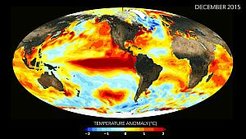Nearly nine billion more tonnes of CO2 through El Niño
The climate phenomenon known as El Niño occurs in the Pacific every four years on average. During El Niño years, the already increasing levels of the greenhouse gas carbon dioxide (CO2)in the atmosphere, rise even more. With the help of satellite data and ground measuring stations, scientists have now determined that an additional 8.8 billion tonnes of CO2 entered the atmosphere in 2015/2016 as a result of the El Niño effect. This is equivalent to a quarter of all annual anthropogenic carbon dioxide emissions. The researchers blame the drought caused by El Niño in the southern hemisphere, which weakens vegetation so that it absorbs less CO2 than usual.

It has long been known that an El Niño event releases large amounts of greenhouse gases such as carbon dioxide (CO2) into the atmosphere. However, the extent of the additional CO2 release has so far only been incompletely quantified, as CO2 measurements could only be taken from a few ground stations. During the last El Niño in 2015/16, the third most powerful since the middle of the 20th century, scientists were aided by satellites, which can continuously measure atmospheric CO2 from space.
Additional CO2 release by El Niño has been incompletely numbered so far
Armed with these data, an international research team, which included researchers from the Max Planck Institute for Chemistry and the Max Planck Institute for Biogeochemistry, calculated that the 2015/16 El Niño resulted in the additional release of around 2.4 billion tonnes of carbon or 8.8 billion tonnes of CO2 into the atmosphere. This is equivalent to about a quarter of the amount released each year by human activities. To put this in perspective, around 0.8 billion tonnes of CO2 from fossil fuels were emitted in Germany in 2015.
Dietrich Feist, scientist at the Max Planck Institute for Biogeochemistry, explains the significance of the study: “Our findings are important because we can now estimate the magnitude of natural fluctuations in greenhouse gas concentrations in relation to man-made changes.” The researcher from Jena operates a station for measuring atmospheric trace gases on Ascension Island in the Atlantic. It is currently the only station available in the equatorial region for checking the satellite data.
CO2 emissions caused by fire are subordinate with respect to the carbon content of the atmosphere
Previously, estimates of the rise in carbon dioxide relied mainly on observations of drought-induced peat, bush and forest fires, which occur more frequently during El Niño years. Earlier satellite data, however, did not agree with the new figures: based on the thermal radiation from fires and the carbon dioxide and carbon monoxide content of smoke trails, scientists had calculated “only” about 0.75 to 1.2 billion tonnes of additional CO2 emissions during the El Niño in 2015/16. The new figure of 8.8 billion tonnes of additional carbon dioxide therefore suggests that emissions generated by fires have only a subsidiary effect on the carbon content of the atmosphere. It is very likely that drought-stricken vegetation in the southern hemisphere is unable to absorb as much CO2 as usual. The researchers expect that this vegetation effect will be reversed in subsequent years by increased plant growth.
Increasing plant growth will compensate for the weakened vegetation
Johannes Kaiser of the Max Planck Institute for Chemistry in Mainz, adds: “Even though the El Niño effect appears to be reversible, we were able to show in previous studies that up to one billion tonnes of CO2 irreversibly escape into the atmosphere from peat fires every year. These fires are clearly man-made due to the expansion of palm and wood-fibre plantations in Indonesia and can surpass the carbon emissions from fossil fuel burning of entire industrialized nations.” Kaiser and his team have been analyzing satellite-based observations of vegetation fires since 2012. He helped design the recently published study and presented the data on fire-related carbon emissions.
In addition to the scientists from Mainz and Jena, researchers from Japan, the USA, Canada, New Zealand, Australia, and Belgium participated in the study. They used complex computer models as well as data from the American NASA satellite OCO-2 and the Japanese JAXA satellite GOSAT, both of which measure the carbon dioxide content of the Earth’s atmosphere. Data from the Total Carbon Column Observing Network (TCCON), a network of measuring stations which includes the one on Ascension Island, were also used, as well as emission estimates from the Global Fire Assimilation System (GFAS), a system that compiles fire-related emissions of greenhouse gases and aerosols in near real-time.
